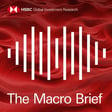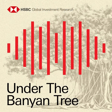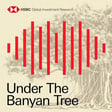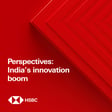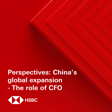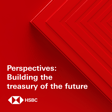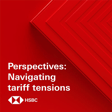Become a Creator today!Start creating today - Share your story with the world!
Start for free
00:00:00
00:00:01

Under the Banyan Tree – Asia needs gold and gold needs Asia
Fred welcomes HSBC's Chief Precious Metals Analyst James Steel to the podcast for a comprehensive look at the recent gold rally and the critical role that markets including China and India play in the global gold trade.
Click here for appropriate Disclosures, including analyst certifications, and Disclaimers that must be viewed with this podcast: https://www.research.hsbc.com/R/101/Hm6nMSq
Stay connected and access free to view reports and videos from HSBC Global Investment Research, just search for #HSBCResearch on LinkedIn or click here: https://www.gbm.hsbc.com/insights/global-research.
Transcript
Introduction to HSBC Global Viewpoint podcast
00:00:01
Speaker
Welcome to HSBC Global Viewpoint, the podcast series that brings together business leaders and industry experts to explore the latest global insights, trends, and opportunities.
00:00:13
Speaker
Make sure you're subscribed to stay up to date with new episodes. Thanks for listening, and now onto today's show.
Introducing 'Under the Banyan Tree' and focus on Asian markets
00:00:33
Speaker
Welcome to Under the Banyan Tree, where we put Asian markets and economics in context.
Interview with James Steele on gold market trends
00:00:38
Speaker
I'm your host Fred Newman, Chief Asia Economist at HSBC, and I've got a special guest in the studio with me today. James Steele, our New York-based precious metals analyst, is here in Hong Kong.
00:00:49
Speaker
And it's no surprise that he's the man who's in demand right now. Gold is shining bright under the global financial spotlight. recently hitting record highs of above $4,000 US s dollars an ounce. We're going to dig into what's been fueling this spectacular rally and of course what it means for Asia. Plenty to talk about, so let's get started right here under the banyan tree.
00:01:15
Speaker
James Steele, wonderful to have you here. ah You are our precious metals analyst globally, but I have to say you also a bit Mr. Gold. You've been covering global gold markets for many, many years, ah widely respected in the gold community, and this is really...
00:01:31
Speaker
the moment where you shine, no pun intended. it But um before we dive into the market, tell us how you got into covering gold.
James Steele's journey into gold analysis
00:01:41
Speaker
How does a man with the name James Steele start to cover gold?
00:01:46
Speaker
Well, thank you for having me, Fred. And ah the irony of it is my father was a welder and my grandfather was a blacksmith. So for for some odd reason, metals seem to run and the family in the family along with the the last name.
00:02:01
Speaker
But i was um I was employed as a junior economist by by The Economist magazine. And I covered the Middle East, so I learned about petroleum.
00:02:13
Speaker
And then after I left that, went over to a brokerage house in New York and covered commodities in general and became gradually more and more specialized away from oil and towards precious metals. And more specifically, gold. Gold is the dominant market.
00:02:31
Speaker
precious metal. the The silver, platinum, and palladium markets are relatively small compared to gold. So, of course, gold prices have rallied enormously, particularly over the last couple of years.
00:02:42
Speaker
What is really driving from a demand perspective that rallies? Central banks must be buying more. Is there also more private demand? Why is that? And is that something that will likely continue?
Factors driving gold demand: Geopolitical risks and public debt
00:02:52
Speaker
Yes, indeed. And in fact, from the day that I started covering gold until now, the same 12 or 15 factors drive the market, same factors.
00:03:01
Speaker
The trick to analyzing the market is to understand which of those factors is in the driver's seat, which is the dominant one. And right now, it's geopolitical risk, economic policy uncertainty, followed by, I think, an increase in public debt, not private, but public debt,
00:03:16
Speaker
ah and trade issues. And those are very powerful combination because they're all happening at once and it has brought in a lot of new entrants into the market. And ironically, it is the same reason that central banks are buying, very similar to reasons that portfolio manager, asset manager, it's the same principle basically, or as an individual might buy. And and is that is that that that's just a historical you truth, isn't it, that in times of uncertainty, people seek refuge in gold. Yeah, precisely.
00:03:48
Speaker
Precisely. ah You know, and I've heard talk about gold going phenomenally higher. Well, one wouldn't necessarily want to live in a world where gold was out of control.
00:04:00
Speaker
It would not be a good sign. Yeah. um And very often, low gold prices are often a sign of stability. And with what's going on now in markets, it's sort of the peak is that the peak interest during your career that you see this interest in gold? Or have we had those periods before when you look back?
00:04:19
Speaker
Well, we have. And it's always during periods of elevated risk, be it COVID, ah the global financial crisis, short periods such as the the Gulf Wars. and economic difficulties such as the ASEAN crisis in the late 90s, and all of those pinpointed gold.
00:04:37
Speaker
But this is by far the most robust, most dynamic, and most sustained. Now, I want to talk about you know the gold price itself in a moment. but But just before we do that, um lay lay out the the structure of the global gold market
Gold supply, demand dynamics, and market size
00:04:54
Speaker
for us. Where does demand come from? How much supply is there?
00:04:58
Speaker
Give us a sense of sort of the the contours of the market itself. um Well, the gold market is remarkably small compared to the financial markets. um And in many ways, it punches above its weight.
00:05:11
Speaker
In most years, gold all the gold in the world above ground is roughly valued at around 2% of all the financial markets. Now, that's changed in the past few years. But generally speaking, over the past few decades, that's been the level.
00:05:26
Speaker
And so you see it's much smaller than the fixed income or the equity markets. How much is that increasing? How do we visualize that? You'll be surprised. it It fits into less than three Olympic-sized swimming pools.
00:05:42
Speaker
All the gold above ground. 120-odd thousand metric tons. And if you think about it this way, one ounce of gold can be tamped so fine that it will cover a football pitch.
00:05:57
Speaker
Wow. Okay. So that's that's how you make the gold stretch, I guess. exactly um And how much gold is being mined annually? About this year, our forecast is around 3,700 odd tons.
00:06:12
Speaker
Not too much. It doesn't grow that much. I mean, 3,700 tons, how much is it? It's a bunch of cars equivalent. ah Basically, it's really um several heavy-duty horses. You could think of it that way. And another thing that is surprising, I mean, we can get only half an ounce of gold out of one ton of rock of ore coming up from the ground. So you need to mine a lot to get those 3,000. You need to mine a great deal of rock. And this is why the ore grade is dropping.
00:06:40
Speaker
In South Africa, we used to get an ounce of gold for every ton. And now we need about two tons of rock. So it's even harder over time to mine it efficiently. You need to have more and more energy, more and more basically digging more and more stuff out of the ground. Precisely. right Precisely because we've only been looking for oil for about 150 years.
00:07:00
Speaker
We've been looking for gold for 5,000 years. Okay. So we've hosted a lot of those mines. The low-hanging fruit has been picked. now Now, in terms of the – that's very interesting on the supply side. What about the demand side? Where does gold go? I mean I know jewelry is very popular. yeah um There must be industrial uses. But where where does most of it go?
00:07:18
Speaker
um About 50 percent of all physical gold is consumed in jewelry. okay Industry is relatively small, around 6 percent. About a fifth of all gold is stored in central banks.
00:07:30
Speaker
And so it doesn't really move. Only about 20% of that 120,000 tons that I was talking about is actively traded and moves around. Most of it is at home in your jewelry box.
00:07:43
Speaker
And the rest is in central banks. There's a lot also stored in places like Switzerland. um And so ah only 20% of it is moving around and is actively traded. Right.
00:07:56
Speaker
Now, um that that gives us a great overview of the gold market. I want to sort of ask about Asia's role in all of this. And you mentioned something um before we went the studio. You said Asia is important for the gold market and gold is important for Asia. So it cuts both ways.
00:08:13
Speaker
yes indeed.
India's role in the global gold market
00:08:14
Speaker
And maybe let's start with India because – When i as an economist look at an Indian economy, there is even gold price movements tend to impact the economy because it goes through the trade account, it affects the currency yeah and so forth. So tell us a little bit about India's role in the global gold market.
00:08:33
Speaker
Well, in Asia in general, um gold you know gold historically goes where the money is. It started out in the Middle East, it moved into the Mediterranean, into the Greeks and the Romans, it moved to Northern Europe during post-Renaissance period, it then went to North America, and now it's going to Asia.
00:08:51
Speaker
um So almost you can almost look at the flows of gold throughout history and you can identify where are the economic activity is the strongest. And it's natural, it it would massively flow to North America in the last century.
00:09:06
Speaker
And it's it's massively going to Asia now. um And India is so centerrop is one of the centerpieces along with China. And as I said, 50% of all the physical gold is in jewelry.
00:09:18
Speaker
Well, 50% of all jewelry is between China and India. And these are countries that have a profound traditional value. sensitivity. And sometimes it's religious also.
00:09:29
Speaker
In the case of India, it's given in Diwali, the Festival of Light. It's also given during marriages. It's a present from ah mother-in-laws to daughter-in-laws. Now, that's interesting. India, of course, very, very big, but also a smaller economy like Thailand actually...
00:09:46
Speaker
um We see that certainly impacting how the currency trades. Gold is is correlated with certain financial assets in in Thailand. So so how how does Thailand, a smaller economy, play into this?
00:09:59
Speaker
Well, Thailand is a rather like Turkey in the sense that it's ah it's a very significant jewelry manufacturer. and they feed jewelry to much of Asia, also into Europe and North America as well.
00:10:12
Speaker
So that's how that affects the market there. um So it's imports and exports. That's right. and so it goes goes both ways. Yeah, exactly. yes and But it's the the the relevance, just to circle back to India, is very important because there was one year I remember, I can't remember exactly which year, that India's gold import bill was larger than her oil import bill.
00:10:33
Speaker
Wow. Yes. That is a huge number because India doesn't produce any oil either. Yeah. um So it's not as if there was a domestic oil that they could use. And that led the finance ministry to put a tariff on gold.
00:10:46
Speaker
I see. So you will see – To reduce the demand for gold. Because they suffered a a dollar hemorrhage because of the demand for gold. To modulate the demand for for for gold. Right. yeah now Now, that's not so much the case in China because China have plenty of dollars. Now, hold that thought, at Jim, because I think this is a great time to take a quick break. And when we come back, I want to actually talk about China because it has been, particularly recent months, really, at least as far as investors are concerned, a concern bi he really been in the spotlight when it comes to gold
China as a top gold producer and consumer
00:11:19
Speaker
prices. Yes, indeed.
00:11:30
Speaker
Okay, welcome back everybody. And before the break, I talked to our global precious metals analyst, Jim Steele, who's here from New York visiting and we talked about the importance of gold generally in Asia and how Asia is increasingly becoming important for global gold markets. But one economy wanted to talk a bit more about is China's role in this. um Now, as an economist, I obviously follow the news. Partly there's been suggestions that the Chinese Central Bank has been allocating more of its reserves to gold that helped, I think, sentiment in global on gold markets. But tell us about China's role in in in the global gold trade.
00:12:06
Speaker
Well, China's interesting because China leprogged a number of years ago into first place as a gold producer. um So there was a tremendous amount of activity in in mining.
00:12:18
Speaker
And yet, despite that, China was also in some years the largest importer. which is really quite amazing. if you it sort of Can you think about sending corn to the state of Iowa or sending oil to Saudi Arabia? I mean, you you mean you wouldn't do it.
00:12:34
Speaker
um And yet, so China had the dual mantle of being the world's largest producer and the world's largest consumer at the same time. And this was pent-up demand. Before the economic reforms under Deng Xiaoping and the deregulation, owning gold was forbidden in China.
00:12:52
Speaker
whereas it was never the case in India, for instance. And so after 50, 60 years of not being able to to their own gold, ah the population moved into gold very quickly. And 2011 was really the year when we saw imports into China absolutely explode.
00:13:12
Speaker
And there's certainly enough discretionary income. And I think what is important is there is that Jewelry has a dual function. it is also seen as an investment as well as a consumable. So you seem to suggest it's not just a central bank that's driving this demand. It's actually...
00:13:29
Speaker
a lot of just popular demand for for it. it's It's jewelry, it's store of of value. it's Is that the key driver here? That's correct. and and But the People's Bank has – the central bank has been very important. ah I wouldn't diminish their their their role.
00:13:45
Speaker
and But central banks and ah collectively are really the ones that kicked off this rally from 2022. twenty two If you think about it this way, the central banks collectively purchased about 400, 450 tons in the previous five to 10 years.
00:14:03
Speaker
And they leapt-frogged up to 1,100 tons in 2022. And if you compare it to mining, it's almost one out of every three ounces of gold that came out the ground went into a central bank vault, didn't hit the market.
00:14:17
Speaker
and so and and And that leaves less gold for everybody else. And so that bids up the price. to Yes. um yeah Yes. Now, speaking of that, um you know I have to ask about this phenomenal rally that we've seen over the past year, years actually, but it's been accelerating, I think, this year.
00:14:35
Speaker
It's obviously hard to predict where prices are going. um How do you feel about the current gold price in terms of the historical perspective, particularly um from a real inflation-adjusted
Historical vs. current gold prices in real terms
00:14:48
Speaker
perspective? Is gold really that expensive at the moment as it appears when you just look at the screen and you read, wow, 4,000 US dollars per ounce. It's never been that high.
00:14:57
Speaker
but But historically, is that really true that it's never been this high? Yeah. Well, it is recently. In fact, we did an article for The Alchemist, which is the LBMA, the London Bullion Market Association, sort flagship.
00:15:09
Speaker
And ah it amused me that last year, a lot of talk about gold hitting new highs. Well, gold hit, and this is the sort of thing, if you're an analyst, that that you know and wouldn't normally bandy about.
00:15:22
Speaker
But gold hit $850 1980.
00:15:27
Speaker
ah The year that Paul Volcker came in the year that Ronald Reagan and and and the year after Maggie was elected. Maggie Thatcher. Maggie Thatcher, excuse Margaret Thatcher, for those of you. not You don't know her personally. Overly. Yes. um And that equates to roughly a little bit under $3,400 in today's money, roughly.
00:15:47
Speaker
and in real so In real terms. In real terms. So so it wasn't until April of this year that we broke over $3,400 level. And then I thought, OK, not only are we at all-time highs in nominal terms, we're at all-time highs in real terms as well.
00:16:06
Speaker
So this is really a very special period. Now, really um this has been a fantastic conversation. But before letting you go, one very last question. You mentioned you wrote an article for The Alchemist, which is the – the Journal of the London Bullion Market Association. Yes.
00:16:23
Speaker
Now, that raises a question in my mind. um Is there a risk that somebody can produce gold artificially at some point? The reason why I'm asking is because in a diamond space, we now have a lot of artificial diamonds around and that obviously, you know, jewelry diamonds are tending towards the artificial stuff.
00:16:41
Speaker
It's been a lifelong dream of mankind to produce gold artificially. Is that on the card? Yes, in fact, ah which is where the Alchemist, the the name of the magazine, which I'm sure triggered it. ah Gold in minute quantities is found in seawater.
00:16:56
Speaker
But you'd need the size of Lake Erie to get anything that was significant. So, no, there's there doesn't seem to be any possibility that I'm aware of, of any work that would allow economically,
00:17:11
Speaker
One to produce gold. yeah it It really is a unique metal in the sense that it's malleable, it's conductable, it provides a lot of functions.
00:17:23
Speaker
There's enough of it to make it popularly traded, but not so much of it as to debase the currency. And that's the perfect... ending to this podcast. Our podcast also is not too much out there, just the right amount.
00:17:38
Speaker
Once a week, everybody, Jim, it's been a pleasure as always. um We'll have you back here next time you come through Hong Kong and we'll we'll check in with you on the latest Trends on Gold.
00:17:49
Speaker
um That's it, everybody. It's all we've got time for. Great having you with us and do join us again at the same time next week under the banyan tree is an HSBC Global Investment Research production, as is our sister podcast, The Macro Brief. Do give that a listen as well. Listen, like, and subscribe, and we will talk to you again very soon.
00:18:36
Speaker
Thank you for joining us at HSBC Global Viewpoint. We hope you enjoyed the discussion. Make sure you're subscribed to stay up to date with new episodes.
